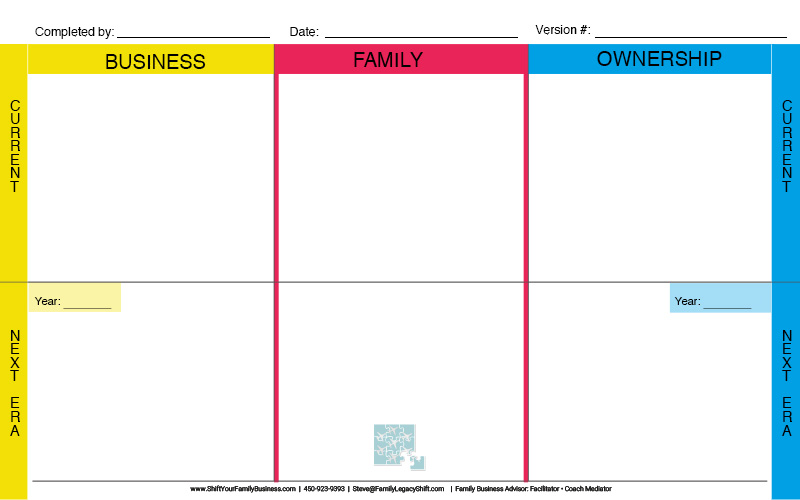Thanks to Steve Legler for this week’s article –complete with the sample page that facilitates the process he describes. See below for Getting Everybody on the Same Page (By Getting EveryTHING on One Page).
Yours in Practice,
The Practitioner
Helping Business Families Find Clarity
As advisors who work with families in business, we know from the get-go that things are likely to be complex. There will be issues of varying degrees of importance in the business, the family, and the ownership — especially in areas where the three circles overlap.
When we first get involved with a family, there are usually plenty of questions to ask before we can add any value — because understanding the family’s situation is fundamentally important.
Sometimes we are brought in a with a relatively clear task, and our work is straightforward. There are often other professionals involved with tasks from their field of expertise, and we need to coordinate our work with theirs.
Rarely do we come into a situation where everything is crystal clear, either to the members of the family or to the advisor group. If only we could have everything on one page, so that we could get everybody on the same page.
The Family Continuity BluePrint
I have conceived a working version of such a document, which I have dubbed the Family Continuity BluePrint. I have begun using it and sharing it with a few others, and the preliminary results are quite promising.
It was inspired by the concept of the “Business Model Canvas” that has become popular recently in the field of start-ups.
My family business version is quite simple and consists of three columns across the top. There is one column titled Business, another called Family, and a third named Ownership. I trust that these sound familiar to fellow practitioners.
Where We Are Now — and Where Do We Want to Go
The simplest form of the BluePrint involves just two time periods: Current, and some Future date. I use a simple legal-sized sheet in landscape format, and there are only six boxes to fill in.
We have the three columns representing the Three Circles, and the two rows, with “Current” along the top, and the “Next era” along the bottom.
(A more advanced version adds another row in the middle, for an intermediate timeframe, and/or “How to get there”)
Completing the BluePrint
This document was conceived to interact with members of a family, either together or separately. It is logical to complete it horizontally, i.e. one timeframe at a time; what is the current state of the business, the family, and the ownership; and then move on to the future state of each column.
In order to explain the document here, I will discuss what goes into each box, column by column.

Click here for a PDF version of the document.
The Business Column
This is where the facts about the business are gathered. Numbers represent as annual sales, number of employees, number of locations, business lines, etc. It is a snapshot that one would use to give a stranger a quick overview of the business.
In the top row, we fill in the current situation. Along the bottom, for the “Next era,” we encourage the members to guesstimate what the business could look like X years from now. The main goal is to open everyone’s eyes to the fact that even at a moderate growth rate, a business can double in size more than once in a matter of a decade or two.
The Family Column
The Family column can be the most revelatory of the three, and it also allows the advisors to show off their genogram skills, because that is the main tool used here.
In the top row of the Family, you draw a genogram of the family members over three generations. The current age of each person is noted, and a notation is made to identify those who work in the business, as well as those who have an ownership stake. Simple color-coding easily accomplishes this.
The bottom row is the most fun to complete, and it is relatively straightforward. The genogram is updated to the time X-years in the future. If we are looking 15 years out, for example, that 10-year-old grandchild now becomes 25, the 40-year-old middle manager becomes 55.
Depending on the ages and the number of years out, you may need to draw some dotted lines to denote possible changes such as additional spouses and children.
Once again, the goal is to make the family members think about what will happen just by adding a number of years to everyone’s age, which happens by itself, God willing.
The Ownership Column
This column usually goes from a pretty simple picture in the top row to a more complex one at the bottom, and that is often the crux of what is at stake for the family.
We outline the percentage ownership of everyone who owns shares in the business. The top row will show what is usually a straightforward structure with parents owning most or all the business, and children owning minor percentages.
The bottom row is where the head scratching really begins. Looking X-years into the future, the business will hopefully have grown to the numbers shown in the lower left box, and the family will have aged and grown to what is shown in the central lower box of the BluePrint.
In 99% of the cases, the ownership structure that is in place today will no longer be the optimal one for the future state of the business and the family.
The Timeframe Question
Determining the X in the term X-years in the future is more art than science. Some family leaders are ready to state that they are planning to step aside at a certain age, and this will be helpful. Note that “step aside” here can involve management of the business or ownership, or both.
The trick is to find a year far enough into the future to make a difference (I suggest 5 years as a minimum, preferably 10) and anywhere up to 20 or 25 years on the outside. If you go too far out, there is a lot more guess work and it can become less meaningful.
I like 10 to 20 years, and if forced to choose a default number, 15 is the safest bet.
So, Just What is a BluePrint?
- A Document – live and dynamic
It is a place to record information, but the information evolves and changes, and the document can and should reflect that.
- A Conversation Starter
While it is a place to record information, the facts that go into it are not always generally known and agreed upon. As such, it acts as an important conversation starter and raises questions that need to be addressed.
- A Family Project
Because family members have different perspectives, completing the BluePrint becomes a family project, as everyone comes to understand what is involved and how they can contribute.
- A Map, a Reference, a Checklist
As the document takes shape and clarity and a consensus emerges, the BluePrint becomes the map and the reference document. A checklist of To-Do items can also be included.
For the Practitioner: Becoming the Coordinator
As practitioners who serve business families, one of the key advantages that we bring is the outsider’s unbiased perspective.
With that perspective, we can (hopefully) also offer clarity to the complex situations that a family confronts. Families are often very unclear on what the issues are and helping them map things out on one sheet of paper, so that everyone can understand them, is a great place to start.
We often look to become one of the family’s most trusted advisors and being the one who brings clarity can be an enormous advantage to help get us there.
We know the Three Circle Model, and we have likely talked to our client families about concepts related to it. Why not go back to that simple concept to try to clarify the areas that need to be attended?
Clarity for the Sake of Coordination
Completing a document that helps the family see where it is now, and where it wants to go, while using the three circles is the simplest way to capture all the important information.
As the family completes its BluePrint, the family members become clear on many things that had been, at best, foggy. As their clarity increases, they can then interact in a much more informed way with their advisors, as well.
When you lead a family through this work, you are well placed to work with and coordinate the work of the other advisors as well, if that is one of the value-added services that you hope to deliver.
Getting everything on one page helps to get everyone on the same page.
About the contributor
 Steve Legler, CFWA, is a family legacy advisor based in Montreal, Canada. He believes in “helping business families to create the harmony they need to support the legacy they want.” He can be reached at sl@stevelegler.com.
Steve Legler, CFWA, is a family legacy advisor based in Montreal, Canada. He believes in “helping business families to create the harmony they need to support the legacy they want.” He can be reached at sl@stevelegler.com.





